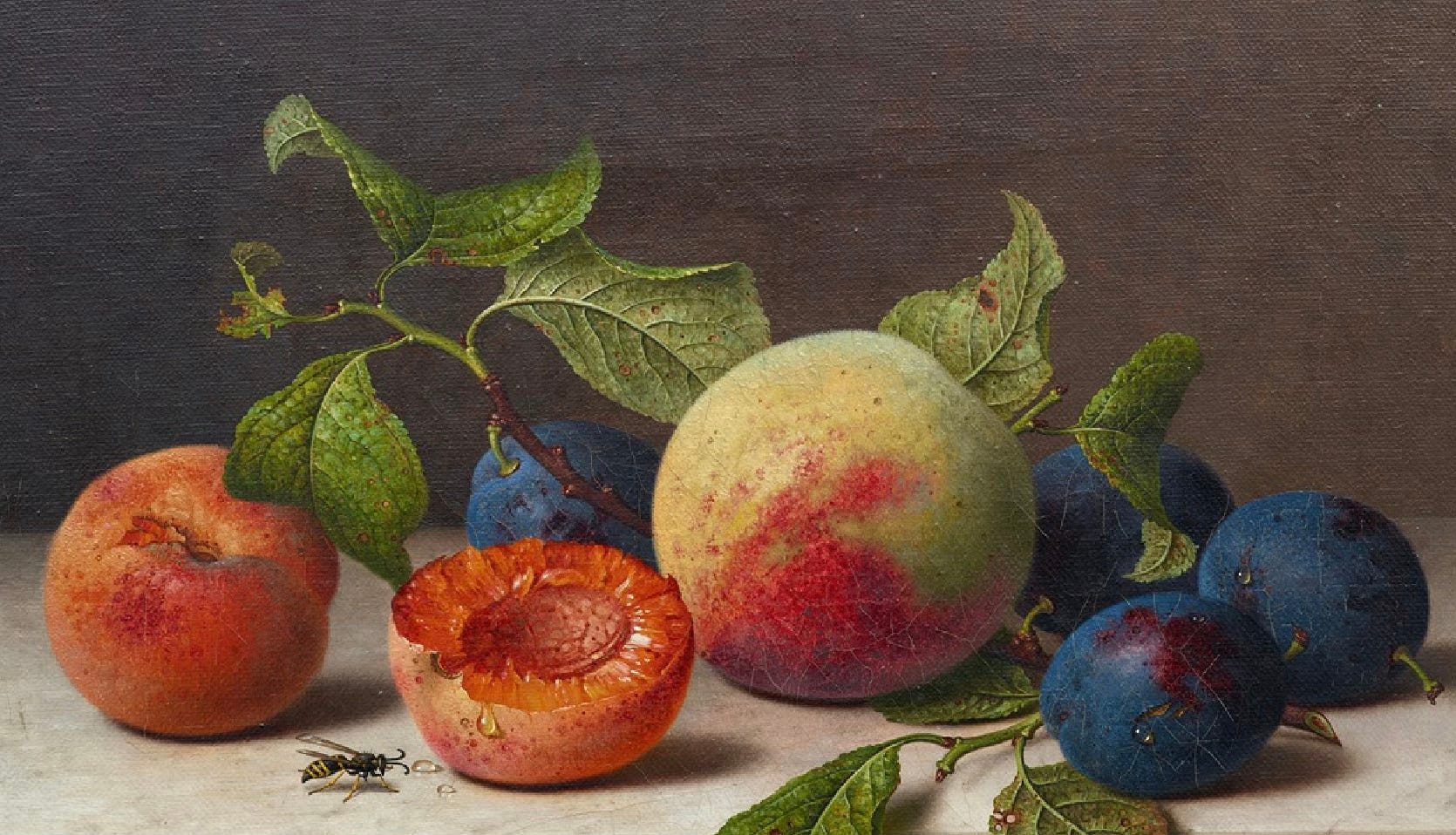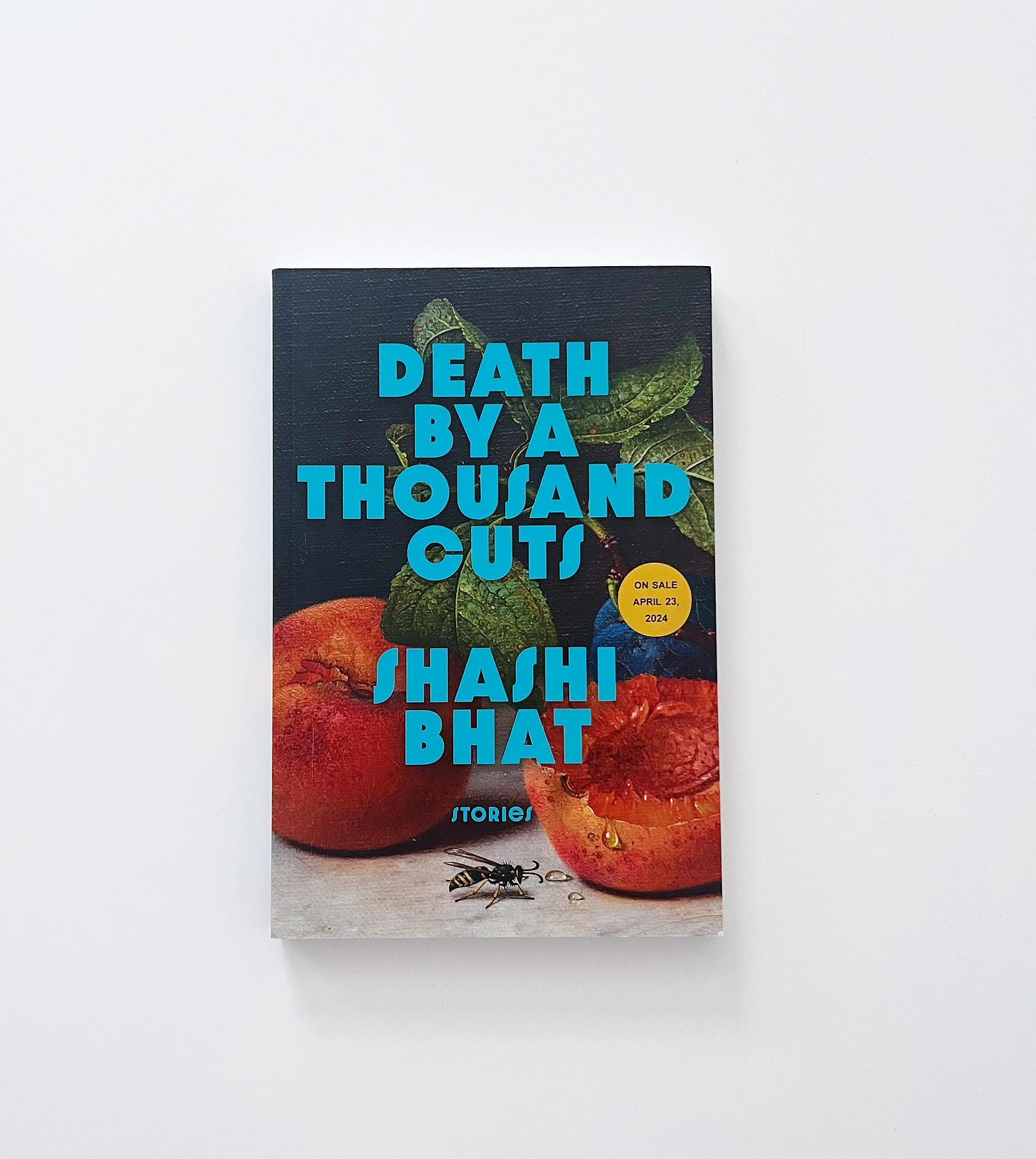An interview with Shashi Bhat
The author of Death by a Thousand Cuts on the importance of reading and writing short stories

In February I read “Her Ex Writes a Novel” on Hazlitt. It had been a while since I’d encountered a reading experience like the one I had that winter afternoon; the story stole me away, on a trip through every emotion one wishes to encounter while reading but rarely does in one sitting—astonishment, disgust, rage, awe. Immediately after finishing the story, I wanted more.
The nine stories in Shashi Bhat’s new collection Death by a Thousand Cuts are bold, humorous, and startlingly relatable. They largely explore the world of female intuition: occasions when women are forced to balance civility with survival. In Dealbreaker the narrator, Asha, endures a cringeworthy date with a man who seems to be lying about his career and living situation. Readers will find themselves laughing one moment (being shamed on a subreddit for calling children “raw, unbaked people” was a highlight) and in a panic the next as Asha forms a plan to escape from her date whose behaviour becomes increasingly unhinged as the night advances. Even later, as the man berates Asha over text for breaking things off, she worries if he’ll know when his number is blocked. Many of the stories evoke the famous quote attributed to Margaret Atwood—“Men are afraid women will laugh at them. Women are afraid men will kill them.”
Identity, dating, beauty and the desire to belong are recurring themes in Death by a Thousand Cuts. The captivating title story follows a young South Asian woman as she considers a revolutionary procedure that will turn her brown eyes blue. In Chicken & Egg the narrator begins rapidly losing hair to a mysterious affliction; her doctor initially dismisses her concerns despite the woman knowing something is wrong. “The body is an unreliable narrator,” muses the protagonist in We’re All in This Alone. “It has biases, subjectivity. The body misleads you—I’m always wondering whether I’m reading it wrong.” Indian Cooking is told from a daughter’s perspective in the days and weeks following an incident where hot oil perverts her mother’s face into something resembling “a beef Wellington”. The injury is temporary, the burns will heal, though Bhat has captured the way in which women obsess over perceived abnormalities, become obliterated by them.
"I’ve devoted my life to short stories in a way that defines me," Bhat, who grew up on Vonnegut and Steinbeck, shares in our interview. Her lifelong passion is on full display in this lucent and textured collection, a must-read for any short story aficionado.
In Death by a Thousand Cuts you establish the world of each story so well—I especially loved “Indian Cooking” and “Dealbreaker” in this regard. What excites you most about short fiction? When an idea arrives for a story, how do you know when to follow it?
Thank you! There’s so much I love about short stories, but most of all I love their shape—the opportunity to create a pronounced, intense rising action and a gut-punch or lump-in-the-throat ending, which I find rarer in the longer span of the novel, where endings tend to involve more of a winding down.
I have a note in my phone called Story Ideas, where I jot down phrases like “lit mag staff plans dead bird theme issue during paper shortage” or “stranger says, ‘something good is going to happen to you,’” i.e. anything that in the moment feels like it could become a story. The ideas that never make it off the ground are the ones where I can’t envision a trajectory; where I haven’t figured out how to escalate tension in a way that will have both thematic resonance and emotional impact.
Dialogue is notoriously one of the hardest aspects of a story to get right, and there are so many great, clever exchanges in this collection that feel very honest and true to life. I’m curious how you, as a writer, find yourself interacting with the world when you’re away from the desk? Are you writing in your head as you’re picking up groceries, do you glean bits of inspiration from strangers, or is writing something that’s only done when you enter a certain environment?
My favourite way of interacting with the world is through the writer lens. It makes me more alert, more attentive. It gives everything I do an extra layer of purpose. Anything I witness or experience could find a second home in a story. For example, while in the middle of a revision, I saw a girl on the Vancouver SkyTrain wearing headphones and sort-of shimmying as she walked, so I plucked that image and re-planted it into my story. I like thinking about how if I hadn’t taken the SkyTrain that day, a different image might have made it in there instead.
Sometimes encountering something in real-life can drastically change a story, too. My early drafts of the title story, “Death by a Thousand Cuts,” were just about a college student trying to work up the nerve to break up with her boyfriend. It was originally titled “Self Surgery” and had a whole other narrative thread involving a re-telling of the urban legend where the devil shows up to a small-town dance. More than a decade after first writing that story, I happened to come across something on the internet about a surgery that could turn brown eyes into blue eyes. I don’t even remember what I was looking up at the time, but this procedure seemed so surreal I decided to put it into the story. I ended up cutting the urban legend thread and re-shaping the central relationship around the idea of thoughtless microaggressions and how they lead that story’s young South Asian narrator to consider having this eye procedure. It was a bit of an experiment, adding that to the story, and I think it provided more thematic heft. If I’d done a different google search that day, who knows what my book would’ve been called!
“My favourite way of interacting with the world is through the writer lens. It makes me more alert, more attentive. It gives everything I do an extra layer of purpose. Anything I witness or experience could find a second home in a story.”
—Shashi Bhat
Who are your favorite storytellers, what are the books/characters that influenced you to write stories of your own?
As teenager I loved Kurt Vonnegut short stories, for their mix of humour and humanity. I also read Of Mice and Men repeatedly, which perhaps explains my fondness for a soul-shattering ending. And I had what I then considered guilty pleasure reads, books like Bridget Jones’ Diary and The Princess Diaries series. I realize now that those were narratives about the experiences of women and girls, and that we didn’t get much of that in the fiction that was taught in school, aside from, like, The Handmaid’s Tale. In my twenties: Jhumpa Lahiri, ZZ Packer, Aimee Bender, Lorrie Moore, Isabel Huggan, Stacey Richter, and many of those unforgettable frequently anthologized short stories, like “Bullet in the Brain” by Tobias Wolff and “In the Cemetery Where Al Jolson Is Buried” by Amy Hempel. More recently: Danielle Evans, George Saunders, Souvankham Thammavongsa, Dantiel W. Moniz, KD Miller, Claire Keegan, Carmen Maria Machado. The books I read are mostly fiction, and while it’s a mix of novels and short stories, the short stories tend to be the ones that remain in my mind, and that I return to.
Do you find that the characters continue to live in your head after a story is published, do you continue to get ideas or imagine what certain characters might be doing after the fact? How do you know when a story is complete?
Usually I don’t continue imagining the life of a character after a story is finished, and maybe that’s because the story is finished. I’ve completed the narrative arc. I’ve published it. It’s like saying “goodbye” when you’re done playing with the Ouija board—now the spirit can’t leave the board and haunt you.
I’m not always done with themes and subject matter though. Those tend to recur. And there is one exception with characters—in my last book the protagonist was a high school teacher. In my day job I teach creative writing to college students, so I often have things happen where I think, oh, that could have happened to Nina. But it’s too late now!
How did you decide on Death by a Thousand Cuts for this collection’s title?
When I sent the manuscript to my agent and then to my editor, I had titled it, “We’re All in This Alone,” which is the name of one of the stories. I liked the ironic wordplay and how it reflected the book’s themes of loneliness, but the title was similar enough to that of another book by the same publisher that it might have been confusing. So after running through a few options, my editor and I decided on “Death by a Thousand Cuts,” the title of another story in the book, and now I prefer it to the original title. I like how bold and sharp it sounds, and how it suggests the theme of accumulating injustice and harm that becomes ultimately devastating, a gradual tearing down—this theme is present in some way in every story in this book.
“For me, emotion drives writing, and the character is a route to the emotion.”
—Shashi Bhat
Readers will find the stories in this collection shockingly relatable—there’s something refreshingly natural about them, but there’s also that element of feeling exposed, like you’ve uncovered a raw nerve that almost everyone has in common. The last story, “Am I the Asshole,” is a poignant conclusion, because it highlights the themes you’ve written about with such proficiency throughout the collection. How long does it take to get a feel for each narrator or character? What is your process for inhabiting their world, developing their voice, and writing the story in a way that is new from anything you’ve previously written?
I love what you said about uncovering a raw nerve—thank you. That’s exactly what I was going for. It varies for me, how long it takes to get a feel for a character or for the world of a story. Sometimes it depends on how similar the character is to me—if they’re much younger or in a different stage of life. But “Am I the Asshole,” for example, felt like it wrote itself. I had such momentum while writing it; it was instinctual, even though the idea for it came from a dozen places—from Reddit and Quora posts and anecdotes I’d heard and articles I’d read and from personal experience. But it was as though thinking about what happens in that story gave me enough rage to propel me through writing it.
For me, emotion drives writing, and the character is a route to the emotion. So once I know what impact I want the story to achieve, I shape the characters around that, trying to make them feel like real humans taking believable actions, but I have an emotional goal in mind. I will also often give myself a creative challenge or constraint, in an effort to write something new-to-me. With “Am I the Asshole,” I used a shifting limited-third perspective, and the hardest work was in the dialog—making the relationship seem lived-in and maintaining that balance between realism and satire, while also managing the two characters’ perspectives so that they felt equally believable, not wanting the boyfriend to seem like a caricature of a Reddit boyfriend, and controlling the use of humour as it falls away and the story becomes something much darker.
This is now the third book that you’ve published. What have you learned—whether a pleasant surprise or something you might have not considered before—about the publishing process with Death by a Thousand Cuts?
My last two books were novels/novels-in-stories, so this is the first time I’ve really had to reckon with the general public’s lack of interest in the short story. I’m a literary magazine editor who teaches short story writing and has an MFA in fiction, and I’ve been in love with the short story since I was a child reading Budge Wilson’s The Leaving, so I’ve devoted my life to short stories in a way that defines me. With my last book, the chapters worked as standalone stories, and some readers didn’t like that the endings feel uncomfortable, that they don’t fully resolve, the sense of omission, etc., but all of that is characteristic to the short story form, and I live for that stuff! Short stories are so artful, such a tightrope walk, such an exquisite challenge—to make a lasting impression in 5,000 words.
I feel very lucky to have an editor and publisher who champion the short story. And I work and socialize in a bubble of folks who value short stories, too. Still, I’ve heard everyone from close friends to acquaintances to people on the internet casually say they don't like short stories, and I always feign politeness while being secretly deeply offended. I want to ask, “But how many short stories have you read? When’s the last time you read a short story—high school English?” Honestly, I take it way too personally. Probably I need therapy. People should read what they want to. But I wish they wanted to read short stories.
Shashi Bhat is the author of three books, most recently, Death by a Thousand Cuts, and was short-listed for the 2022 Governor General’s Award for fiction. Shashi is the editor of EVENT magazine and teaches creative writing at Douglas College.
To buy a copy of Death by a Thousand Cuts, consider supporting one of Shashi’s favourite bookstores: Massy Books, Wildfires Bookshop, Book Warehouse, Upstart & Crow, Pulpfiction Books, and Bookmark Halifax.







Absolutely LOVED this interview!! 😍